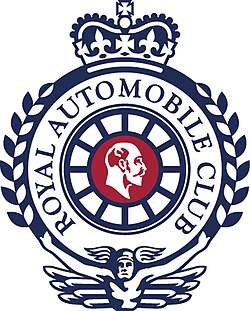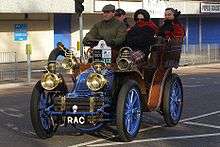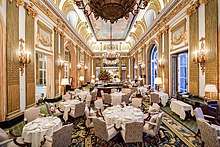Royal Automobile Club
The Royal Automobile Club is a British private social and athletic club that is not to be confused with RAC Limited, an automotive services company, which it formerly owned.
 King Edward VII at the centre of a wreathed wheel, supported by a winged Mercury | |
| Formation | 10 August 1897 |
|---|---|
| Type | Social and athletic club |
| Location | |
Chairman | Ben Cussons |
President | Prince Michael of Kent[1] |
| Website | royalautomobileclub |
Formerly called | Automobile Club of Great Britain and Ireland |
It has two clubhouses: one in London at 89 Pall Mall, and the other in the countryside at Woodcote Park, near Epsom in Surrey, both with accommodation and a range of dining and sporting facilities. The Royal Automobile Club welcomes both men and women as members.
History

It was founded on 10 August 1897 as the Automobile Club of Great Britain (and, later, Ireland).[2] The headquarters was originally in a block of flats at 4 Whitehall Court, moving to 119 Piccadilly in 1902.
During 1902 the organisation, together with the recently formed Association of Motor Manufactures and Traders campaigned vigorously for the relaxation of speed limits claiming that the 14 mph speed limit imposed by the Locomotives on Highways Act 1896 was 'absurd' and was seldom observed. The organisations, with support from the Prime Minister Arthur Balfour, had considerable influence over the forthcoming Motor Car Act 1903 which originally proposed to remove all speed limits for cars while introducing the offence of driving recklessly. In the face of considerable opposition a speed limit of 20 mph was retained in addition to the creation of the offence of driving recklessly, dangerously or negligently.[3]
In 1905, the Club organised the first Tourist Trophy (TT) motorcycle race, the oldest regularly run motor race. The Club became the governing body for motor sport in Britain. King Edward VII's interest in motoring led to the command in 1907 "that the Automobile Club of Great Britain and Ireland should henceforth be known as The Royal Automobile Club".[4] In 1911, they moved to the current address, part of the site of the old War Office; the club house was (and remains) one of the largest in London, with a frontage to Pall Mall of 228 feet and a depth, in the centre, of 140 feet. It cost over a quarter of a million pounds and is described in the Survey of London as "a polished essay in the late French Renaissance manner".
At the outbreak of the First World War in August 1914, the Club arranged for twenty-five of their members, with their personal cars, to accompany the British Expeditionary Force to France and Belgium to act as chauffeurs and messengers for the British General Staff. Describing themselves as the "RAC Corps of Volunteer Motor Drivers", the drivers included the Duke of Westminster, Lord Dalmeny and "Toby" Rawlinson; many of them were given commissions and went on to give distinguished war service.[5] In September 1914, a further group of RAC members put themselves and their cars at the disposal of the British Red Cross, to help transport war casualties.[6]
The RAC was responsible for organising the first British Grand Prix motor race at Brooklands, Surrey in 1926 and also runs its sister organisation, the MSA (formerly RAC MSA).
In 1978 during a re-organisation the 'Associate Section' was established as a separate company RAC Motoring Services Ltd, which was owned by the organisation.
In 1991 the RAC Foundation was split off as the research arm of 'RAC Motoring Services'. When RAC Motoring Services was sold in 1999 the Foundation was granted a legacy and was subsequently established as a charity to research and promote issues of safety, mobility, economics and the environment related to motoring.[7]
In September 1999 members sold RAC Motoring Services to Lex Service plc, who renamed themselves RAC plc in 2002. RAC Plc was then acquired by Aviva plc in March 2005 for around £1.1 billion.[8]
Associate section (RAC Motoring Services)
The RAC introduced uniformed mobile patrols around the roads of Britain during 1901 with the patrolmen wearing a uniform not unlike the military police of the day, including tailored jodhpur trousers. The patrolmen had an army-like rank structure with corporals, sergeants and officers. Mounted on Matchless motorbikes with sidecars containing a tool kit, fanbelts, engine hoses, and metal cans of spare petrol they were usually located on standby at laybys and major road junctions. Until around 1930 control could only contact the mobile patrolmen by telephone, so they waited by public telephone boxes for the callout. From 1957 onwards they were equipped with radio sets for two way contact with their local headquarters.
In 1912, following the lead of the competitor organisation The Automobile Association (AA), the RAC installed roadside telephones on laybys and junctions of the main trunk roads in the UK for members to summon help. Although they were never as numerous as AA boxes there was a measure of cooperation between the two motoring clubs—keys fitted both types of box and members' messages were passed on. The telephones were installed in locked boxes painted in royal blue with the RAC logo badge mounted on the top of the box. Members were provided with a key to the boxes when they joined the club.
Members' cars were identified by a metal club badge usually affixed to the radiator grille and the patrolmen would come to attention and salute as a member drove past, or, if the patrolman was riding a motorcycle, merely salute. This practise was the basis of an unofficial service given by the club to its members; sometimes a patrolman would not salute when driving past, in order to warn the member that they were about to encounter a police speed trap
The RAC issued an annual 'Guide and Handbook' that contained road maps of the UK with the location of all RAC telephones marked on it, together with lists of local RAC approved garages and hotels. To give members an indication of the quality of each establishment the RAC was one of the very first organisations to provide an easily recognisable grading system. Their inspectors assessed each hotel and garage and awarded between one and five stars in the case of hotels and one to three spanners to garages. The RAC disbanded its hotel inspection team in 2004.
Motorcycle patrols gave way to small vans during the 1960s and by 1970 the last motorcycle patrols had been phased out. RAC telephone boxes were withdrawn from service when they were eclipsed by wider telephone ownership and by the 1990s only a handful still operated on holiday routes in the West Country. The advent of mobile phones made the need for roadside telephones redundant and the last of the RAC telephones were removed from service. Roadside assistance is now provided by vans and recovery vehicles.
Until the early 1970s the RAC did not have a formal "onward to destination" service for members. If the patrolman was not able to complete the repair at the roadside, arrangements were made for an RAC approved garage to tow the vehicle and repair it at the owner's cost, with the owners being responsible for making their own arrangements for travel by public transport or hired vehicle. This changed in the 1970s with the first of the low-loading vehicle transporter fleet and the introduction of a higher membership tier of the Recovery service. Similarly, until the early 1980s the roadside assistance service was limited to locations away from home, which only changed with the addition of an At Home level of service.
In 1978 the Associate section was split off to form RAC Motoring Services Ltd and subsequently sold in 1999 (then renamed RAC plc).
Facilities

The Club is the best equipped of all the Pall Mall clubs. It includes 108 bedrooms, seven banqueting rooms, three restaurants, a business centre, a full-size marble swimming pool, squash courts, a billiards room and Turkish baths. The country clubhouse near Epsom also has accommodation and restaurants as well as sports facilities, which include two 18-hole golf courses.
Chairmen of the Royal Automobile Club
The governing body of the Club is its board of directors, which is presided over by the chairman.[1]
- 1897–1904, Roger William Wallace, QC (first chairman)[9]
- 1904–1905, Brig.-General Sir Henry Capel Lofft Holden
- 1905–1907, The Hon. Sir Arthur Stanley
- 1907–1908, Sir Charles Rose, 1st Baronet
- 1908–1910, H.S.H. Prince Francis of Teck
- 1910–1912, Lt-Col. H.H. Adolphus Cambridge, 1st Marquess of Cambridge
- 1912–1936, The Hon. Sir Arthur Stanley, MP
- ...
- 2018–present, Ben Cussons[1][10]
Presidents of the Royal Automobile Club
- 1904–1911, George Sutherland-Leveson-Gower, 3rd Duke of Sutherland (first president)[1]
- 1911–1942, Prince Arthur, Duke of Connaught
- 1942–1943, Prince George, Duke of Kent
- 1943–1979, Louis Mountbatten, 1st Earl Mountbatten of Burma
- 1979–present, Prince Michael of Kent
See also
- List of London's gentlemen's clubs
- RAC Limited
References
- "Governance and Management". Royal Automobile Club. Retrieved 3 February 2019.
- "Royal Automobile Club website". Retrieved 23 August 2011.
- Criminal on the Road. pp. 67–69. Retrieved 26 February 2010.
- Royal Automobile Club – History
- Messenger, Charles (2005). Call to Arms: The British Army 1914–18. Weidenfeld & Nicolson. ISBN 978-1-7802-2759-7.
- "British Red Cross Transport during the First World War" (PDF). www.redcross.org.uk. British Red Cross Society. Archived from the original (PDF) on 4 November 2017. Retrieved 14 October 2016.
- "History". RAC Foundation. Archived from the original on 3 March 2012. Retrieved 26 February 2010.
- "Archived copy". Archived from the original on 29 June 2009. Retrieved 17 April 2011.CS1 maint: archived copy as title (link) RAC History
- "Royal Automobile Club (RAC)". Grace's Guide. Retrieved 3 February 2019.
- Ben Cussons
External links

- Official website
- Survey of London—illustrated architectural account of the London club house